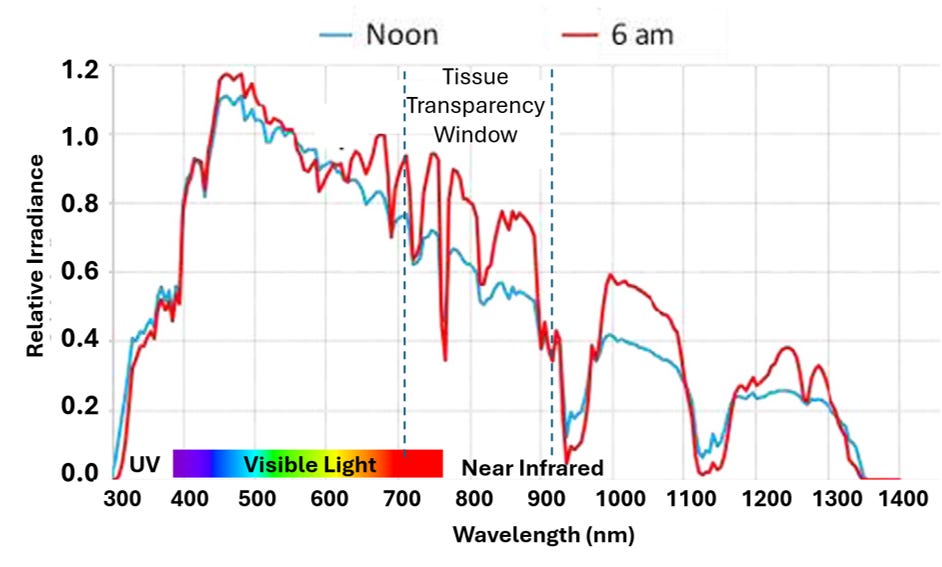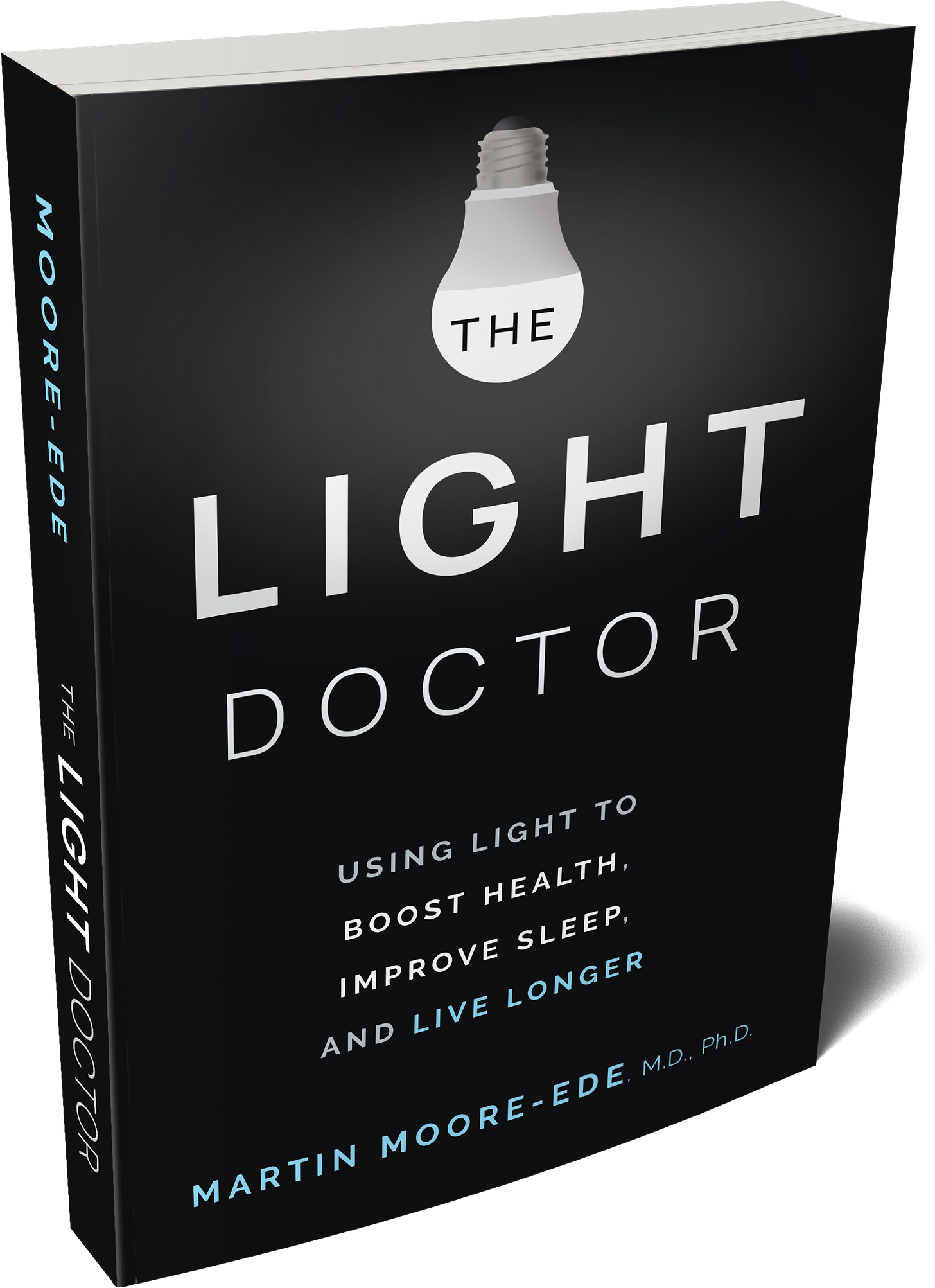Invisible Healing: Near-Infrared Light and Health
When infrared light penetrates our body it energizes the batteries of cellular metabolism and reverses the effects of ageing and disease.
It is human nature to focus only on what we can see, and that is certainly true of the light in our world. Only 39% of natural daylight is visible to the human eye. The majority (54%) of sunlight is invisible infrared light, which we experience as warmth1.
Recent research reveals just how important this infrared light is to our health. When this infrared light penetrates our body it energizes the mitochondrial batteries which power cellular metabolism, and reverses the effects of ageing and disease.
Today we live in an infrared-deprived world where the average person spends only 7% of their time outdoors. The increasing use of E-Glass in our windows, which blocks infrared rays to keep buildings cool, and LED lights that provide only a narrow range of visible light wavelengths with little deep red, and no infrared, narrow the light spectrum we experience indoors in the name of energy efficiency. We are no longer exposed to the near-infrared light generated by the wood fires, candles, and incandescent light bulbs of past years.
The Light Wavelengths That Penetrate Our Body
Of particular interest is deep red light from 650 - 750 nm, and near-infrared light in the 750 nm to 900 nm range, which can penetrate multiple centimeters deep into the body. This “tissue transparency window” shown in Figure 1 is limited by hemoglobin absorption at the lower end and by water absorption of infrared wavelengths at the upper end2.

The depth of penetration into tissue depends on the wavelength of the red or infrared light and its intensity. Red light in the 650 - 670 nm range is effective in reducing skin dermatitis after radiation3, and in restoring the retinal function in the ageing eye4.
However, to reach deeper tissue near-infrared light must be used. The peak tissue transmission is at about 800 - 850 nm, where infrared light, depending on its intensity, and how much melanin pigment is in the person’s skin, may penetrate up to 8 cm of depth5.
You Don’t Have to Get Undressed to Reap the Benefits
Infrared light at 850 nm penetrates normal clothing (e.g. undervest + shirt + sweater) 100 times more effectively than red light at 660 nm. Unlike ultraviolet and blue light which are blocked by clothing, you can get the full health benefits of infrared light with your normal clothes on. Dense fabrics like denim and ski outfits block more of the infrared while cotton and polyester let most of the infrared reach your body6.
Energizing Your Cellular Batteries
When red and near-infrared light penetrates the body it stimulates the mitochondria within the cells. Mitochondria are the small intracellular batteries that use glucose and oxygen to produce chemical energy in the form of adenosine triphosphate (ATP) which powers metabolism. As people naturally age, or are impacted by disease, mitochondrial ATP production declines and the mitochondria also produce reactive oxygen species that contribute to systematic inflammation. Exposure to near-infrared light can reverse these deteriorations of mitochondrial function.
One of the key enzymes in ATP production is mitochondrial cytochrome c oxidase. Its peak sensitivity to infrared light is about 835 nm7. This is close to the infrared wavelengths that penetrate to the maximum depth in the Tissue Transparency Window.
Time of Day Matters
The greatest response of mitochondria to red and near-infrared light exposure is in the morning hours. This is when the circadian rhythm of natural ATP production is at its peak8. Exposures to the same dose of red light in the afternoon and evening hours have little or no effect. Interestingly, the morning is the time of day when the solar spectrum contains the greatest relative proportion of near-infrared light (See Fig 2).

Similar time of day effects of red light in restoring mitochondrial function are seen in small insects such as drosophila and bees. For example, hives of bees that have been poisoned by insecticides can be restored to good health by red light treatment.
Remote Effects
Red and near-infrared light does not have to penetrate deep into the body to have systemic effects. For example, irradiating human skin with 670 nm red light for 15 minutes can have a substantial effect on glucose tolerance. The rise in blood glucose levels after drinking a sugar drink was reduced by 28% in people previously treated with this red light shone on their backs. Similarly, irradiating the back of a mouse with infrared light can improve their retinal function.
This suggests that red and infrared light causes chemical changes in circulating cytokines and other molecules that may transit the benefits of red and near-infrared light beyond the specific areas that are irradiated. In addition, red and near-infrared light stimulates the production of intracellular melatonin, which is an antioxidant.
Transition to Human Medicine
Studies in animal models have shown the benefits of correcting mitochondrial malfunction using near-infrared light in a number of conditions, including brain injury, Parkinson’s disease and multiple sclerosis. As yet there have been relatively few clinical studies in human subjects, although this is a promising active area of research.
Should our indoor lighting provide near-infrared?
Our indoor lights, as we discussed earlier, used to provide near-infrared from wood fires, candles and incandescent light bulbs, which emit 88% infrared light. Are the dosages we received from these indoor light sources high enough to matter for our health?
A recent study indicates the answer may be yes. LED lights with added near-infrared in the 800 - 1000 nm range were shown to have a calming and relaxing effect, as compared to LED lights without added infrared9. The measure they used was heart rate variability, a marker of sympathetic versus parasympathetic nervous activity. This is part of our body’s autonomic control system which can either activate us in times of danger or challenge (sympathetic nervous system). or calm us down when we are safe and can relax. (parasympathetic nervous system). The study volunteers had a significant increase in relaxation measured by heart rate variability, and an increased subjective sense of pleasure when the lights contained infrared wavelengths.
Even though incandescent light bulbs are banned because they cannot meet the 2023 US Department of Energy (DOE) energy standard of 45 lumens per watt, alternatives are available. For example, NIRA A18 and BR30 light bulbs supplement an LED chip with an incandescent filament to provide visible light plus near-infrared light up to 3000 nm. Also PhosphorTech has a cap which converts the output of a regular LED light bulb into a spectrum that adds substantial infrared.
The challenge is that the near-infrared in the spectrum is treated as wasted watts by DOE regulations so while they can achieve 50 lumens per watt, these light bulbs cannot meet the 125 lumens per watt minimum standard that comes into effect in 2028.
This is one of the reasons why we have petitioned the US DOE to create a new product class of General Wellness Light Bulbs that would not be subject to the 125 lumens per watt minimum, For further information please visit https://circadianlight.org/campaign/
In the meantime, get outdoors in the mornings
The richest source of near-infrared light is sunlight, or even daylight on a cloudy day. So, get outside in the mornings. This is the time of day when the relative infrared content of daylight is highest, and the time when the boosting effect of infrared light on mitochondrial energy production is most effective.
For more insights into what we have done to ourselves by moving indoors and switching on narrow spectrum blue-rich LED lights, see my book THE LIGHT DOCTOR.
Sources
Barolet D. et al (2016) Infrared and skin: Friend or foe. Journal of Photochemistry & Photobiology, B: Biology 155: 78–85 http://dx.doi.org/10.1016/j.jphotobiol.2015.12.014. The remaining 7% of solar radiation is ultraviolet light.
Fosbury R and Jeffrey G (2024) Life-life interactions beyond photosynthesis. https://herschelsociety.org.uk/wp-content/uploads/2024/02/The-Astrophysics-of-Earth_v3.3.pdf
Zhang et al. (2018) Application of red light phototherapy in the treatment of radioactive dermatitis in patients with head and neck cancer. World Journal of Surgical Oncology 16:222 https://doi.org/10.1186/s12957-018-1522-3
Shinhmar H, et al (2021) Weeklong improved colour contrasts sensitivity after single 670 nm exposures associated with enhanced mitochondrial function. Sci Rep. 2021 Nov 24;11(1):22872. doi: 10.1038/s41598-021-02311-1. PMID: 34819619.
Zimmerman S. and Reiter RJ. (2019) “Melatonin and the Optics of the Human Body,” Melatonin Res. 2 (1) 138-160; doi: 10.32794/mr11250016)
Saleem A et al (2013) Near Infrared transmission through various clothing fabrics. J. Textile Sci Eng 3:2 DOI: 10.4172/2165-8064.1000129
Mason MG et al (2014) Re-evaluation of the near infrared spectra of mitochondrial cytochrome c oxidase: Implications for non-invasive in vivo monitoring of tissues. Biochimica et Biophysica Acta 1837: 1882–1891 http://dx.doi.org/10.1016/j.bbabio.2014.08.005
Shinhmar H et al (2022) Shifting patterns of cellular energy production (adenosine triphosphate) over the day and key timings for the effect of optical manipulation. J Biophotonics. 15:e202200093. DOI: 10.1002/jbio.202200093
Roddick CM et al. (2024) Effects of near-infrared radiation in ambient lighting on cognitive performance, emotion, and heart rate variability Journal of Environmental Psychology 100: 102484





Just interviewed Dr. Alexander Wunsch on this topic:
https://www.thepowercouple.ca/electrohealthsummit